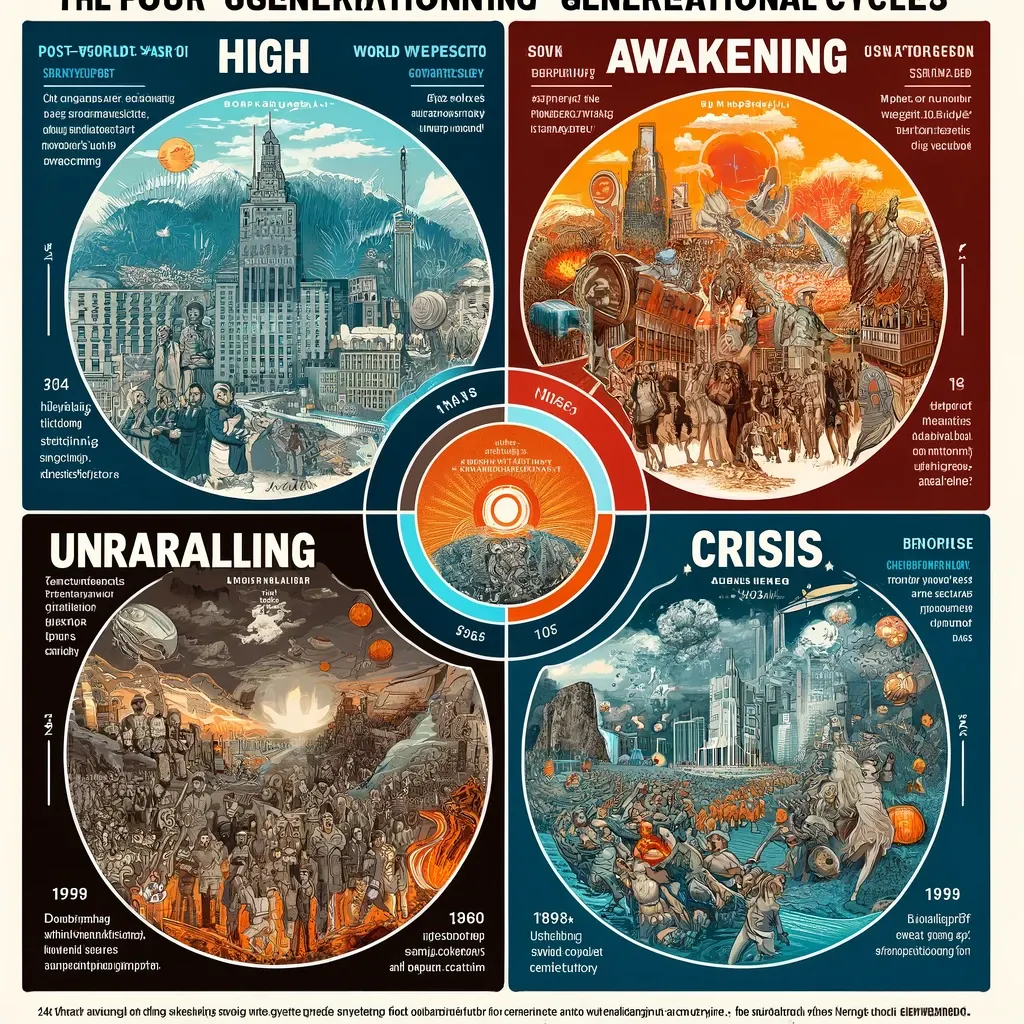The Fourth Turning, how to prepare
In a rapidly evolving world, understanding the patterns of history can offer valuable insights. Neil Howe, a renowned historian and demographer, presents a compelling analysis of generational cycles and their implications in his presentation, "The World Is Changing Fast! Do This Now To Prepare." This blog delves into Howe's concepts of historical cycles, particularly focusing on the "fourth turning," and explores its relevance to current events and future projections.
Generational Cycles
Explanation of Cyclical History
Neil Howe posits that history moves in generational cycles, akin to the seasons of the year. Each cycle comprises four turnings: high, awakening, unraveling, and crisis. We are currently in the "fourth turning," a crisis period characterized by significant upheaval and the potential for profound societal transformation.
Evidence and Historical Examples
- Great Depression and World War II: These events marked the previous fourth turning, leading to widespread economic and social restructuring.
- Post-World War II American High: This era exemplified the renewal phase following a crisis, characterized by strong institutions and societal cohesion.
Implications for Today
Recognizing these cycles can help anticipate future changes and prepare for the opportunities and challenges they bring. Understanding the patterns of history provides a roadmap for navigating the current crisis and shaping the future.
Millennials and the Fourth Turning
Unique Position of Millennials
Millennials, now entering their prime years, are uniquely positioned to influence the course of the current fourth turning. This generation's values, experiences, and technological savvy equip them to drive significant societal changes.
Potential for Societal Change
- Challenges: Millennials face economic instability, social inequality, and environmental concerns.
- Opportunities: Leveraging technology, innovation, and a collaborative spirit, Millennials can address these challenges and reshape institutions to better serve society.

Historical Patterns
Historically, the generation coming of age during a crisis often leads the rebuilding process. For example, the "GI Generation" played a pivotal role in post-World War II reconstruction. Similarly, Millennials have the potential to spearhead a new era of societal renewal.
Historical Context and Patterns
Characteristics of Fourth Turnings
Fourth turnings are marked by crises that disrupt the status quo, often involving economic collapses, major wars, or significant social upheavals. These periods are high stakes but also offer the opportunity for major restructuring and renewal.
Analysis of Past Fourth Turnings
- Great Depression and World War II: Resulted in economic and political restructuring, leading to the establishment of the modern welfare state and the United Nations.
- Civil War: Brought about the abolition of slavery and a redefinition of federal-state relations in the United States.
Current Fourth Turning
Today’s crisis encompasses economic inequality, ineffective institutions, and geopolitical tensions. Understanding past fourth turnings helps anticipate the trajectory of current events and the potential for significant societal transformation.
Future Projections and Implications
Potential Outcomes
The aftermath of the current fourth turning could lead to a "golden age" with stronger institutions, greater public trust, and enhanced social cohesion. However, achieving this outcome requires addressing current challenges effectively.
Challenges to Address
- Inequality: Reducing economic and social disparities is crucial for long-term stability.
- Institutional Effectiveness: Reforming and strengthening institutions to better serve public needs.
- Geopolitical Tensions: Navigating international relations to ensure peace and cooperation.
Planning for the Future
Strategic planning and long-term investments are essential to capitalize on the opportunities presented by the current crisis. Emphasizing innovation, sustainability, and resilience will be key to building a stable and prosperous future.
Strategies for Preparation
Community and Family Support
Strengthening community and family bonds is vital for navigating the uncertainties of the fourth turning. These social structures provide support, stability, and a sense of belonging during turbulent times.
Personal and Financial Planning
Diversification and long-term planning are crucial strategies for individuals and families. Investing in education, skills development, and sustainable practices can help mitigate the impact of the crisis and prepare for future opportunities.
Practical Steps
- Building Resilience: Developing skills and capabilities to adapt to changing circumstances.
- Fostering Innovation: Embracing new technologies and innovative approaches to problem-solving.
- Cultivating Relationships: Strengthening social networks and community ties to enhance support systems.
Conclusion
Neil Howe’s analysis of generational cycles offers valuable insights into the current fourth turning and its implications for the future. Understanding these patterns helps individuals and communities prepare for significant societal changes and capitalize on emerging opportunities. By fostering resilience, innovation, and social cohesion, we can navigate the crisis period and work towards a stable and prosperous future.
References for Further Knowledge
Books:
- "The Fourth Turning" by William Strauss and Neil Howe
- "Generations: The History of America's Future" by William Strauss and Neil Howe
Articles:
- Journal of Generational Studies
- Historical reviews on economic cycles and societal changes
Webinars:
- Talks and interviews with Neil Howe
- Webinars on generational theory and its applications in modern society
